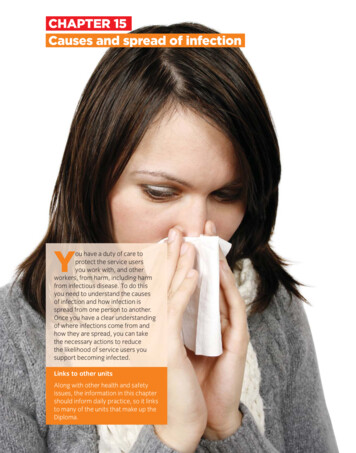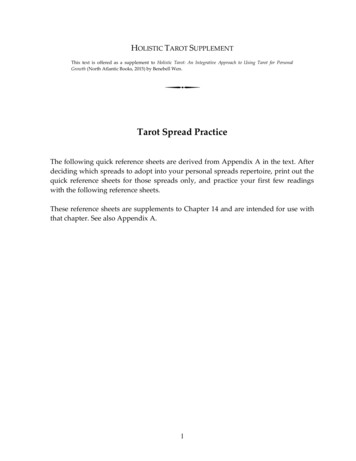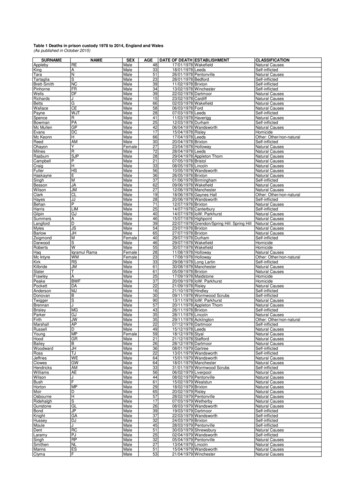
Transcription
CHAPTER 15Causes and spread of infectionYou have a duty of care toprotect the service usersyou work with, and otherworkers, from harm, including harmfrom infectious disease. To do thisyou need to understand the causesof infection and how infection isspread from one person to another.Once you have a clear understandingof where infections come from andhow they are spread, you can takethe necessary actions to reducethe likelihood of service users yousupport becoming infected.Links to other unitsAlong with other health and safetyissues, the information in this chaptershould inform daily practice, so it linksto many of the units that make up theDiploma.
THE DIFFERENCES BETWEEN BACTERIA, VIRUSES, FUNGI AND PARASITESIn order to understand the causes and spread of infection you need tounderstand:Key termsMicroscopic means so small as to bevisible only with a microscope.Pathogen is a bacterium, virus, or othermicro-organism that can cause disease.Not all bacteria, viruses or other microorganisms are pathogenic; they will not allcause disease in humans.Bacteria are microscopic organisms, sometypes of which are pathogenic. Bacteria aremade up of just one cell and are capable ofreproducing themselves.Virus is a pathogenic microscopicorganism. Viruses cannot multiply on theirown, so they have to invade a ‘host’ cell.Pathogenic fungi are yeasts and mouldswhich can infect humans.Parasites are organisms that live on otherorganisms. what is meant by the term ‘infection’ how infection is spread from person to person the means (routes) by which the body becomes infected how the body can be affected by bacteria, viruses, pathogenicfungi and infectious parasites the chain of infection.THE CAUSES OF INFECTIONInfection is harm caused by micro-organisms, which are often referredto as ‘germs’. Micro-organisms (microbes) are living organisms sosmall that they cannot be seen without the use of a very powerfulmicroscope – they are microscopic. Micro-organisms that causeinfection are known as pathogens. Bacteria, viruses, pathogenicfungi and parasites are all examples of micro-organisms that cancause infection.THE DIFFERENCES BETWEEN BACTERIA,VIRUSES, FUNGI AND PARASITESThe different kinds of micro-organisms have different characteristics.BACTERIABacteria are classified into different groups and can be pathogenic(capable of causing illness) or non-pathogenic (not likely to causeillness). Different types of bacteria are identified by their varyingshapes.Bacteria are simple organisms, made up of just one cell, and arecapable of reproducing by themselves. They do this through a processof growing to twice their original size and splitting into two; those twocells then split into two more, and so on. This may appear to be a verysimple process; however, conditions have to be right for it to happenand for the bacteria to be viable. Under the right conditions they candivide and multiply rapidly. The term used for this process is binaryfission.Bacteria exist everywhere, including inside and on our bodies. Most ofthem are completely harmless and some of them are very useful. Forexample, most strains of Escherichia coli (E. coli) are required as part of424HSC L2.indb 424THE CITY & GUILDS TEXTBOOK04/09/14 5:51 PM
CAUSES AND SPREAD OF INFECTIONthe normal gut flora, as it has beneficial functions such as helpingwith the production of vitamin K2. Bacteria in the large intestinehelp with the final stages of digestion.CHAPTER 15Key termFlora are microorganisms that normallyinhabit the body without causing harm.However, some bacteria are pathogenic and can cause diseases,either because they end up in the wrong place in the body, or simplybecause they are ‘designed’ to invade us. Some bacterial infectionscan make people very ill, while others have a fairly mild effect. Differentstreptococcal infections which are caused by strains (or varieties) ofthe bacterium Streptococcus can range from being mild, such as asore throat, to life-threatening, as in necrotising fasciitis (in the latterthey are often called ‘flesh-eating’ bacteria). Group A Streptococcusis commonly found on the skin and inside the throat, and in manypeople does not cause any symptoms at all. It is important to notethat bacteria may have non-pathogenic and pathogenic strains. Asmentioned above, most strains of E. coli do not cause us harm, but thestrain known as E. coli O157:H7 can cause food poisoning if ingested.Key termsBacteria tend to be vulnerable to an antibiotic, which is why peoplewho have a bacterial infection are often prescribed antibiotics. Itis important to understand that bacteria can become resistant toantibiotics as a result of several factors: Bacteria can mutate and eventually become resistant to specificantibiotics. If a person is treated with an antibiotic it is possible for thatantibiotic to destroy harmless bacteria that live in and on theperson, and this allows harmful bacteria to multiply and taketheir place. It is believed that the over-use of antibiotics in recent yearshas played a large part in antibiotic resistance, and the rise ofwhat are often called ‘superbugs’, such as methicillin-resistantStaphylococcus aureus (MRSA).Antibiotic is a substance from a microorganism that is used to destroy othermicro-organisms or prevent their growth.Resistance is the ability of a microorganism to withstand an antimicrobialagent.Nowadays, doctors and GPs have to think carefully before prescribingantibiotics. Officials at Public Health England (PHE) remind GPs thatmany patients do not benefit from antibiotics even if the patientsthemselves think that they do. Health officials have acknowledged thepressure on GPs to prescribe, but have warned them that it adds to thecycle of antibiotic resistance.PHE and the Royal College of General Practitioners have issuedguidance to help GPs explain to patients when antibiotics are notneeded. The TARGET antibiotics toolkit can be seen at http://www.rcgp.org.uk/TARGETantibiotics/.LEVEL 2 DIPLOMA IN HEALTH AND SOCIAL CAREHSC L2.indb 42542504/09/14 5:51 PM
THE DIFFERENCES BETWEEN BACTERIA, VIRUSES, FUNGI AND PARASITESVIRUSESViruses are much smaller than bacteria, and more complex. Theycan survive out of the body for a time. Viruses are not affected byantibiotics, which is why antibiotics are not prescribed for viralinfections. There are, however, antiviral drugs available to treat someinfections. Viruses cannot multiply on their own, so they have toinvade a ‘host’ cell and take over its machinery in order to be able tomake more virus particles. They do this by latching on to human cellsand getting inside them. Viruses consist of genetic materials (DNA orRNA) surrounded by a protective coat of protein.Key termsDNA (Deoxyribonucleic acid) is sometimescalled ‘the blueprint of life’ because itcontains the code for building organisms.RNA (Ribonucleic acid) acts as amessenger of the above mentioned codewhen new cells are formed.The cells of the mucous membranes, such as those lining therespiratory passages we breathe through, are particularly open tovirus attacks because they are not covered by protective skin. As wellas all cold and flu infections and most coughs and sore throats, virusesare also the cause of many serious infectious diseases. In order to getrid of a virus, the cell which has been invaded by the virus must bekilled, which results in damage to the cells themselves. For this reasondoctors can only control the symptoms of a viral infection, but to datemedical research has found no cures.When a virus invades the body, the immune system releases whiteblood cells. These cells produce antibodies, which cover the virus’sprotein coat and prevent it from attaching itself to the cell. Whiteblood cells also destroy infected cells and thus kill the virus before itcan reproduce. Unfortunately, some viruses such as measles, influenzaand mononucleosis (glandular fever) weaken the immune system for aperiod of time.PATHOGENIC FUNGIPathogenic fungi can be either yeast or moulds, including yeasts(single-celled), and mushrooms and moulds (multi-celled). A fungus is asimple plant-like organism. Unlike plants, fungi do not make their ownfood. Some species of fungi get their nutrition by breaking down theremains of dead plants or animals. Others are parasites. Examples offungal infections include athlete’s foot, thrush and ringworm. Fungalinfections are not often the cause of healthcare-acquired infections;however, it is possible for an individual to acquire an infection such asringworm in a healthcare environment.426HSC L2.indb 426THE CITY & GUILDS TEXTBOOK04/09/14 5:51 PM
CAUSES AND SPREAD OF INFECTIONCHAPTER 15PARASITESSome parasites are very complex; many are pathogenic and causeinfection and can be spread from person to person. Parasitesusually enter the body through the mouth or the skin. For example,threadworms, sometimes known as pinworms, are small, white,thread-like worms a few millimetres long that live in the human gut.The female worm lays eggs around the anus, which often leads toitching and scratching. Eggs can then become stuck to fingertips orunder the fingernails and can be transferred to other people, food,children’s toys, kitchen utensils or even toothbrushes. Other peoplethen come into contact with the eggs, and if they touch their mouthsand swallow the eggs they become infected with the threadworm.Scabies is a contagious disease caused by tiny mites (Sarcoptesscabiei). The main symptom of scabies is itching caused by the miteburrowing under the skin. Scabies is spread by skin-to-skin contactwith an infected person; this is the most common method. It can alsobe spread by sharing clothes, infected linen, towels and so on with aninfected person.COMMON ILLNESSES AND INFECTIONSCAUSED BY BACTERIA, VIRUSES, FUNGI ANDPARASITESThe following table is not an exhaustive list, but is provided to furtherillustrate the types of illnesses that are caused by micro-organisms.ConditionType ofmicroorganismOutlines of )VirusAIDS is the final stages of HIV (HumanImmunodeficiency Virus). Mostcommon modes of transmission areunprotected sex, sharing infectedneedles, HIV-positive mother tobaby during pregnancy, birth orbreastfeeding.BronchiolitisVirusMostly common in babies and youngchildren. Mode of infection is usuallydroplet infection from infected peoplesneezing and coughing.LEVEL 2 DIPLOMA IN HEALTH AND SOCIAL CAREHSC L2.indb 427Key termTransmission means passing an infectiousdisease from one person to another.42704/09/14 5:51 PM
COMMON ILLNESSES AND INFECTIONS CAUSED BY BACTERIA, VIRUSES, FUNGI AND PARASITES428HSC L2.indb 428ConditionType ofmicroorganismOutlines of transmissionChickenpoxVirusCommon childhood illness. Modeof transmission is that it spreadsthrough the air in tiny droplets –fifteen minutes in the same room asan infected person is likely to lead toinfection; also spread through skincontact with the blisters.ChlamydiaBacteriaMode of transmission is unprotectedsex or from an infected mother to ababy during birth.Cold and fluVirusCan be spread by droplet infection,or the unwashed hands of an infectedperson touching surfaces.Cold soresVirusModes of transmission include skinto-skin, eg kissing, and sharing itemssuch as cups, towels or any other itemthat has made contact with the coldsore.DiphtheriaBacteriaThe most common mode oftransmission is droplet infection;since the vaccination programmestarted in 1940 this once-commoncause of death in the UK is now rare.Since 1896 there have been 15 casesreported in England and Wales. It is,however, still common in some otherareas of the world.DysenteryBacteria orparasiteThere are two main types ofdysentery; the most common typein the UK is caused by the Shigellabacteria. Amoebic dysentery is causedby an amoeba (single-celled parasite)called Entamoeba histolytica, whichis mainly found in tropical areas. Bothtypes of dysentery are commonlypassed on through poor hygiene,and people often become infected byeating contaminated food.THE CITY & GUILDS TEXTBOOK04/09/14 5:51 PM
CAUSES AND SPREAD OF INFECTIONConditionType ofmicroorganismOutlines of transmissionGlandularfeverVirusMostly infects young adults. Commonmodes of transmission are kissing,droplet infection from infected peoplecoughing and sneezing, and sharingeating and drinking utensils such ascups, glasses and unwashed forks andspoons.HepatitisA/B/CVirusHepatitis A is caused by faecalcontamination. Hepatitis B can bepassed on through sexual contact,infected needles and from mother tobaby. Hepatitis C is blood-borne socan be passed on by infected blood,contaminated needles, needle-stickinjuries and from mother to unbornchild.ImpetigoBacteriaThis is an infection of the top layersof skin caused by bacteria gettinginto the skin when it is damaged, forexample, by insect bites, tiny cutsand grazes. The mode of transmissionis by contact with blister fluid eitherfrom direct skin contact or by crosscontamination from objects that havetouched the blister fluid such as facecloths, towels, clothing or toys.MeaslesVirusModes of transmission are dropletinfection, either by breathing in thedroplets when an infected person hascoughed or sneezed or by touchingcontaminated surfaces wheredroplets have fallen and then touchingthe mouth or nose area.MumpsVirusSame as measles, above.Norovirus(wintervomiting bug)VirusCaused by a group of viruses callednoroviruses, this is the most commoncause of stomach bugs in Englandand Wales. Modes of transmissionare person-to-person, consumingcontaminated food or water, andtouching contaminated surfaces orobjects.LEVEL 2 DIPLOMA IN HEALTH AND SOCIAL CAREHSC L2.indb 429CHAPTER 1542904/09/14 5:51 PM
COMMON ILLNESSES AND INFECTIONS CAUSED BY BACTERIA, VIRUSES, FUNGI AND PARASITES430HSC L2.indb 430ConditionType ofmicroorganismOutlines of transmissionPoliomyelitis(polio)VirusPoliomyelitis (polio) is a highlyinfectious vaccine-preventabledisease. It invades the nervoussystem, and can cause total paralysisin a matter of hours. It can strike atany age, but mainly affects childrenunder three.PneumoniaVirus orbacteria orfungusPneumonia means inflammation of thelungs usually caused by an infection.RingwormFungusCan affect skin, nails and hair. Themode of transmission is by touchingan infected person, animal or infectedobject or surface, eg shared towels orfarm gates.Rubella(Germanmeasles)VirusDirect contact and droplet infectionbreathed in when an infected personcoughs or sneezes are the commonmodes of s, very itchy skin disorderleading to a rash caused by themicroscopic mite burrowing underthe skin to lay eggs. The mode oftransmission is skin-to-skin contact, egprolonged hand-holding.Scarlet feverBacteriaCaused by the same Streptococcusbacteria that causes impetigo. Thesebacteria are commonly found onthe skin and in the throat, wherethey do not cause any problems.Unfortunately under certaincircumstances they cause disease.Scarlet fever is highly contagious andis transmitted via airborne dropletsfrom coughing and sneezing, and bydirect contact with mucus or salivafrom an infected person or itemscontaminated by droplets or saliva/mucus such as drinking vessels oreating utensils.THE CITY & GUILDS TEXTBOOK04/09/14 5:51 PM
CAUSES AND SPREAD OF INFECTIONConditionType ofmicroorganismOutlines of transmissionTetanusBacteriaTetanus occurs when a flesh woundbecomes contaminated. The bacterialive in soil, house dust and animal andhuman waste.Tinea pedis(athlete’s foot)FungusSpreads easily from person to personon towels, clothing and foot contactsurfaces. The fungi survive andmultiply in warm humid areas such asswimming pools, changing rooms andshowers.TuberculosisBacteriaSpread by inhaling droplets from thecoughs and sneezes of an infectedperson. Most commonly affects thelungs, but can affect any part of thebody.Warts andverrucasVirusVery contagious; modes oftransmission are skin to skin andcontact with infected objects orsurfaces such as the areas aroundswimming pools.WhoopingcoughBacteriaSpread by inhaling droplets from thecoughs and sneezes of an infectedperson.CHAPTER 15TYPES OF INFECTIONThe following are terms commonly used to describe how and wheremicrobes are affecting a person’s body: Systemic infection. This is when the infection caused by a pathogenhas spread through the body to several organs in different systemsof the body, for example, the digestive, respiratory or circulatorysystems. Localised infection. This is an infection that is confined or restrictedto a specific location of the body, for example, an infected wound.Colonisation versus infectionInfection means that the organism is present and is causing illness.Colonisation means that the organism is present in or on the body butis not causing illness. When someone is exposed to a micro-organismLEVEL 2 DIPLOMA IN HEALTH AND SOCIAL CAREHSC L2.indb 43143104/09/14 5:51 PM
THE TRANSMISSION OF INFECTIONsuch as MRSA or Clostridium difficile, they can become colonised.This means that the organism takes up residence harmlessly (forexample, on the skin, in the nose or in the bowel) but does not causean infection. This colonisation may: continue harmlessly indefinitely clear spontaneously develop into an infection.Sometimes it is possible and indeed necessary to use medicaltreatments to help the colonisation clear faster, for example, beforean operation can take place. For this reason screening for MRSA oftentakes place prior to elective surgery, for example, in day cases havingroutine surgery.THE TRANSMISSION OF INFECTIONMicro-organisms that cause infection may originate from:Key terms ourselves (endogenous) micro-organisms which transfer fromone site on the body to another site where they invade and causeinfection other people (exogenous) via hands, equipment, etc the environment, including contaminated food, contaminatedequipment, contaminated surfaces, contaminated laundry, clinicalwaste and dust.Endogenous means originating fromwithin.Exogenous means originating from anexternal source.The difference between infectious and non-infectious disease is thatinfectious disease can be spread from person to person. Infection canpass from person to person by cross-contamination (cross-infection,indirect contamination) or by direct contact (direct contamination).Cross-contamination is where the pathogenic organisms are movedfrom their source to another location and then to a person. Sharingcontaminated objects such as a bedpan or hairbrush can lead to crosscontamination, as can misusing cleaning equipment, for example, byusing cleaning cloths in more than one location. Remember, hands arethe most common vehicles of cross-infection.It is very important to remember that some people are moresusceptible to infection than others. For instance older people,babies and children are more susceptible, as are people with loweredimmunity due to illness or existing health conditions.One of the reasons that the organisms that cause infections spreadso easily is because they cannot be seen by the naked eye. For thatreason we need to be aware of how to minimise the conditions for432HSC L2.indb 432THE CITY & GUILDS TEXTBOOK04/09/14 5:51 PM
CAUSES AND SPREAD OF INFECTIONCHAPTER 15their growth and how they get into our bodies. With this informationwe can start to minimise the chances of transmission of infections.Bacteria live on or in just about every material and environment onthis planet: from soil, to water, to air; from inside home environments,to arctic ice. Every living creature, including humans, is covered withbacteria. Some microbes live on the skin and offer protection fromharmful agents. The drier areas of the body, such as the back andforearm, have few microbes; moist areas, such as the armpit, havemany more. Each square centimetre of skin averages about 100,000bacteria. The forearms, which tend to be dry, average approximately1,000 bacteria per square centimetre, while the armpits may havemany millions per square centimetre.CONDITIONS NEEDED FOR THE GROWTH OFMICRO-ORGANISMSTo multiply and reproduce, pathogenic micro-organisms require thefollowing: moisture nutrients temperature time.MoistureLike most living things, bacteria must have moisture to stay alive.Bacteria will not multiply in dry areas, but as soon as liquid is added,for instance to dried food like powdered milk and dried eggs, theproducts will provide ideal conditions for bacteria to multiply.However, if enough salt or sugar have been added to foods suchas bacon, savoury biscuits, jam and confectionery, this will absorbthe available moisture in the food so the bacteria cannot multiply aseasily. It is not only moist foods that provide the right environment forbacteria, though. Moist skin or damp areas of an environment will alsoprovide the right atmosphere for bacterial growth.NutrientsBacteria, like all living things, need nutrients to survive. Different typesof food-poisoning bacteria can live on a range of foods, but mostprefer food that is moist and high in protein such as meat, poultry,eggs, shellfish, milk and dairy products, cooked rice, pasta, or anyproduct made from these foods.All these foods are subject to bacterial growth even after they havebeen cooked and served cold later. This is why such ready-to-eat itemsare classified as high-risk foods.LEVEL 2 DIPLOMA IN HEALTH AND SOCIAL CAREHSC L2.indb 43343304/09/14 5:51 PM
THE TRANSMISSION OF INFECTIONKEY POINTPhotosynthesis is the process bywhich some organisms use sunlight tosynthesize nutrients from carbon dioxideand water.Bacteria will live on and in people, plants and soil, and they takenutrition from everything from sugar and starch to sunlight, sulphurand iron. Some bacteria are photosynthetic – they can make theirown food from sunlight, just like plants. Also like plants, they give offoxygen. Other bacteria absorb food from the material they live on orin. Some of these bacteria can live off unusual substances such as theelements iron or sulphur. The microbes that live in your gut absorbnutrients from the food you’ve digested.TemperatureMost food-poisoning bacteria multiply at temperatures between 5 Cand 63 C, which is why this range of temperatures is often calledthe ‘danger zone’. Ambient temperatures (room temperatures)are generally within the danger zone. The ideal temperature forbacteria to multiply is around 37 C, which is the average human bodytemperature. When food is kept at temperatures colder than 5 C andhotter than 63 C bacterial growth slows down or stops, but mostbacteria can survive cold temperatures and resume multiplicationwhen conditions are more suitable. Freezing will make most bacteriadormant, but it does not kill them, so when frozen food is thawed it isjust as susceptible to risks as fresh food.TimeWhen bacteria are left in warm conditions on the right type of nutrientwith adequate moisture, they will reproduce quickly. For example,most types of food-poisoning bacteria take around 10 to 20 minutes tomultiply.VIRUSESIn order for a virus to multiply it needs to latch on and invade anappropriate host cell of an animal or plant. Once it is within the ‘host’cell it takes over its machinery and makes more virus particles. Thecells of the mucous membranes, such as those lining the respiratorypassages that we breathe through, are particularly open to virusattacks because they are not covered by protective skin.MAIN ROUTES OF INFECTIONThere are four main routes of infection, or ways in which infectionsenter our bodies:434HSC L2.indb 434 The respiratory tract (nose, windpipe, lungs). Airborne pathogenssuch as those causing coughs and colds can be inhaled. Broken skin. One of the functions of the skin is to provideprotection against infection. This includes the mucous membraneof the nose and mouth. If skin is broken by bites, scratches,THE CITY & GUILDS TEXTBOOK04/09/14 5:51 PM
CAUSES AND SPREAD OF INFECTIONCHAPTER 15puncture wounds or dry chapped skin that breaks down, thisprovides a route for infection to enter the body. The digestive tract. Infected products such as food and drink canbe swallowed, often affecting the bowels or stomach. The urinary tract and reproductive system. Infections may remainlocalised or enter the bloodstream. One of the problems withcatheterisation is the possibility of bacteria being carried into theurinary tract during the catheterisation procedure.COMMON CAUSES OF THE SPREAD OFINFECTIONThe most common causes of spread of infections in a health and socialcare environment are: lack of or poor hand hygiene lack of or poor cleaning procedures lack of, or incorrect use of, personal protective equipment (PPE)such as gloves and aprons contaminated bed linen or clothing infected food handlers – remember, this includes not only thosewho prepare food but also those who serve food or support peopleto eat and drink airborne infection (such as colds and flu).Some of these are described in more detail below.Lack of or poor hand hygienePeople carry millions of microbes on their hands. Most are harmless,but some can cause illnesses such as colds, flu, diarrhoea, hepatitisand E. coli infection when we forget to wash our hands, or don’t washthem properly. We can spread these germs to other people, or givethem to ourselves by touching our eyes, mouths, noses or cuts onour bodies. Microbes can also be picked up from objects such asdoorknobs, taps, and wheelchair handles touched by other peoplewho have not washed their hands. Think about all the things you toucheach day and how many people may have touched them before you.The Hand Hygiene Campaign – Give Soap a Chance states that somebacteria and viruses can stay alive on our hands for up to threehours. They can be spread to all the things touched during that time,including food and other people, so good hand hygiene is of theutmost importance. On its website, NHS Choices, the National HealthService gives a wealth of information about how long micro-organismscan live outside of the body. For instance, cold viruses can survive onLEVEL 2 DIPLOMA IN HEALTH AND SOCIAL CAREHSC L2.indb 43543504/09/14 5:51 PM
THE TRANSMISSION OF INFECTIONindoor surfaces for more than seven days; however, their ability tocause an infection starts to decrease after 24 hours. Also, 40% of coldcausing viruses remain infectious on hands after one hour. Washinghands reduces the number of micro-organisms on our hands and helpsprevent the spread of infection.The following are examples of the types of microbes that can bespread on the hands of health and social care workers: Staphylococcus aureus (including MRSA) Streptococcus pyogenes (Group A Streptococci) Pseudomonas – a bacterium found in soil and water, likely to infectpeople with underlying health problems staying in hospital Clostridium difficile – a bacterial infection that affects the digestivesystem, most commonly affecting people staying in hospital Candida – fungi which live on all surfaces of our bodies; undercertain conditions, they can cause infections such as vaginalthrush, oral thrush, skin and nappy rash rotavirus – a common cause of diarrhoea and sickness adenovirus – a common cause of respiratory tract infections andgastroenteritis, especially in young children; adenoviruses can alsocause conjunctivitis and cystitis hepatitis A virus norovirus.DID YOU KNOW? Around 20% of women and 40% of men don’t wash their hands after using a public toilet. According to research carried out in the United States of America and presented to the InternationalAssociation for Food Protection conference in San Diego in July 2002, 90% of germs on hands arefound under the nails. A right-handed person tends to wash their left hand more thoroughly than their right hand, andvice versa. The number of bacteria can double in 20 minutes, and after one day without hand washing a singlebacterium can multiply 2 billion, trillion times. There are between 2 million and 10 million bacteria between the fingertip and the elbow. The number of microbes on your fingertips doubles after you use the toilet. Pathogens can stay alive on hands for up to three hours. Millions of germs hide under watches and bracelets, and there could be as many germs under a ringas there are people in Europe.(Foodink, Food and Drink Federation)436HSC L2.indb 436THE CITY & GUILDS TEXTBOOK04/09/14 5:51 PM
CAUSES AND SPREAD OF INFECTIONCHAPTER 15Hand hygiene is of utmost importance. It is important that you are fullyaware of your employer’s laid-down policies and procedures relatingto hand hygiene, including which resources should be used for thevarious activities carried out during the course of your daily duties.Generally, washing hands with liquid soap and water is sufficient asyou go about your daily activities. Nowadays, hand rub containingalcohol is available at the entrance to hospital wards and residentialsupport services. It is important that staff and visitors use it onentering and exiting such facilities. If you are supporting a service userfrom a social care environment into a clinical setting such as a hospitalyou must remember that your duty of care still applies, and that youhave a responsibility to ensure that correct hand hygiene is adhered toby you, the person you are supporting and anyone else involved in theservice user’s support and health care.The Code of Practice on prevention and control of infections publishedby the Department of Health within The Health and Social Care Actstates that service providers must ensure that there is adequateprovision of hand-washing facilities, and anti-microbial hand rubswhere appropriate. This clearly indicates the importance of handwashing with soap and water. However, according to the NationalInstitute for Health and Care Excellence (NICE) in its Clinical Guidelines,hand rubs containing 60% isopropyl alcohol and conforming to thecurrent British Standard are the recommended products for ensuringeffective hand hygiene, except when: hands are visibly soiled the patient is experi
strain known as E. coli O157:H7 can cause food poisoning if ingested. Bacteria tend to be vulnerable to an antibiotic, which is why people who have a bacterial infection are often prescribed antibiotics. It is important to understand that bacteria can become resistant to antibiotics as a result of several factors:











